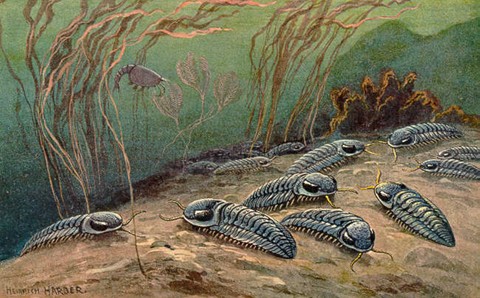
Atop one of our record shelves sits a fossilized trilobite, given to us by a dear friend of the Grand Empress. We’ve long cherished the gift, but as we went about some cleaning chores while catching yesterday’s Ravens-Patriots tilt, a troubling thought entered our consciousness while giving the arthropod a shine: how do we know it’s genuine? It is such a perfect-looking specimen, we now wonder whether the ridges of its exoskeleton were created by human hands.
Alas, we certainly lack the expertise necessary to make such a determination—as do the vast majority of consumers who annually sink millions of dollars into the fossil market. That is why fakes flourish in Morocco, the global capital of trilobites, where the fossil industry employs an estimated 50,000 people. Gathering high-quality trilobites from the Atlas Mountains has become increasingly expensive, since the most accessible specimens were sold off years ago. And so counterfeiting has become something like an art form, albeit with an assembly-line flavor:
Entire specialty workshops have been set up in Morocco to fabricate specific genres of fossils (and artifacts). Now, the suppliers of these fakes are like physicians – each one specializes in a type of trilobite or technique. You have some that only deal in Cambrian fakes, some in Ordovician fakes, this guy makes complete specimens of partial ones, this guy supplies the fake spines, that guy is making complete fakes of free-standing spiny Devonian trilobites. They even package the fakes in the same way, for instance. You will find complete fakes of what seem like meticulously prepared spiny trilobites with all the spines exposed packaged in the same plastic containers that the real specimens come in.
These recommended techniques for sussing out fakes begin with the simple (looking for air bubbles) and move onward to the drastic (sawing a specimen in half). We reckon that few collectors have the wherewithal to try any of these, though. As in all markets dealing with artifacts of globe-crossing provenance, tremendous trust must be placed in middlemen. Fortunately, the bulk of our species tends toward honesty.
(Image via Heinrich Harder, the greatest German paleo artist of the 20th century)


minderbender // Jan 11, 2010 at 4:27 pm
Reminds me of this, although I don’t think the Chinese art is meant to be passed off as genuine.
Brendan I. Koerner // Jan 11, 2010 at 9:51 pm
Thanks for the link to the Fallows post. The gallery by the German photographer is stellar–I found this image particularly poignant for some odd reason:
http://www.photomichaelwolf.com/china_copy_artist/24.jpg
jackal // Jan 12, 2010 at 6:34 pm
On the drive out of Marrakech I noticed a lot of people digging by the roadside (not building roads) — apparently they were digging out geodes. Not sure if there’s a market for fakes of those, but I’m sure some enterprising folks in the medina are working on it if there are..
(As a sidenote, a geologist aunt told me to go see all these interesting geological sites when I mentioned I was visiting Morocco, so I guess it’s a hotspot of geology-oriented travel holidays. Or something like that..)